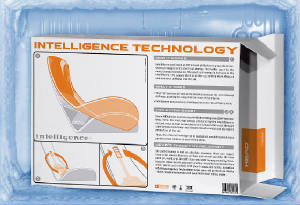|

Intelligence™ Technology - electronic ski
management system
HEAD’S THEORY OF RELATIVITY.
Ski performance is
not an absolute measure. What you want out of a ski always depends on how and where you ride.
On hard-packed slopes
you want perfect edge grip. On soft snow, you want more maneuverability. Breaking the slope record you want your ski to perform
differently than when you’re just cruising with your friends or family.
The vision behind HEAD Intelligence Technology
(originally developed for use in helicopter rotor blades) was to make a ski that delivers perfect performance
relative to any terrain and in all riding modes. The success of Intelligence has proven us right.
How it works
Intellifibers positioned at 45° in front of the
binding transform mechanical impulses into electrical energy. The harder you ride, the more energy is produced.
The
electrical energy is led back to the Intellfibers. This causes them to stiffen up, putting more rebound and torsional stiffness
into the ski.
What it does
The stiffening up of the Intellifibers during high-performance skiing achieves two things:
1)
Their 45° position in front of the binding increases
the ski’s torsional stiffness, pushing the edge
into the
snow in hard turns.
2) Intelligence progressively stabilizes the entire
ski at high speeds.
The extra boost
Some HEAD high-end skis in the 06.07 line boast Intelligence Chip Technology. Here,
the electrical energy produced by the Intellifibers is not just recycled, but accumulated and released bit by bit through
a pre-programmed chip – individually timed to match the oscillation properties of the ski.
Thus, the effect of
Intelligence is multiplied, providing even more performance relative to your skiing style.
Aircoat Technology: (featured in the EVERY THANG ski)
While everybody is trying to make the
core of their skis lighter, we decided to put air in the surrounding fiberglass. AIRCOAT means our fibers are hollow, not
only making our 2007+ freeride and multicondition skis super light, but extremely agile and strong at the same time. This
technology, also used in the aerospace industry, is the main reason, why AIRCOAT equipped skis like Jon Olsson’s new
pro model or the new XENON line will most probably be
the lightest skis on the market next year.
Super Light
40% LIGHTER – Regular glass fibers are solid,
whereas AIRCOAT fibers are hollow. This reduces the overall weight of the fiberglass in a ski up to 40%. And since there is
a lot of glass in a ski, this makes a big difference.
Super Strong
SAME STRENGTH – The hollow fiber has both
a higher
compression strength and a higher specific strength than any solid fiber. This makes hollow fibers at least as
strong as conventional, full fibers.
Super Agile
MORE AGILITY – The combination of lighter weight and increased
strength in Hollow Glass fibers results in more resilience and agility of the ski. Hollow glass fibers are more responsive
and faster in both absorbing and transmitting energy to and from the edge of your skis.
Fly Light
It used to be
that wider skis automatically meant heavier, more sluggish skis. With AIRCOAT HOLLOW Glass Technology we break with that «tradition».
Introducing AIRCOAT to our MOJOS, MONSTERS and XENONs makes you forget about those extra inches. No more overweight baggage.
Claim
your Aircoat
AIRCOAT Hollow Glass Technology was originally developed
for HEAD Park & Powder models – the
target being to make wide skis lighter and more agile. But why shouldn’t
multi-condition skis benefi t from this
ground-breaking technological leap? After all, recreational skiers also have a
right to be riding the lightest and most
responsive skis. Not
just flying through the air, but also flying down the slopes.
To find out, what our new multi-condition
concept is all about, you have to try one of our new XENONs. First we start with a slightly broader platform, then we add
a killer sidecut, and finally we introduce AIRCOAT Hollow Glass Technology. The result is an extremely agile ski with a high
level of stability and great floatation in soft snow. It’s like all-mountain freeriding meets slalom. It’s like
a sportscar meeting an SUV. And most likely it’s nothing like anything
you’ve ever skied before.
Liquidmetal Technology
While Intelligence technology manages our skis’
performance
relative to the rider’s needs, the search for ever stronger and livelier materials in ski construction continues. An
absolute fact is: The more elasticity and rebound a ski construction allows, the more it will make out of your skiing skills
and energy.
PHYSICS CLASS.
Water and ice are the same material – H2O. Water is H2O’s liquid state,
ice is the solid state. The molecules in ice are in a fixed array, with more distance between the molecules and thus, less
dense than the free-moving molecules in water (that’s why ice floats). Ice can break, and putting ice under pressure,
it can be compressed
(under pressure it turns back into water). Water in its liquid state however, cannot be compressed
and it cannot break. This is where Liquidmetal comes in.
Regular Metals
- Flexing solid metals,
their molecular structure is compressed and can be damaged.
- Immediate effect: Energy amortization. No full rebound.
-
Long-term effect: Breaking down of rebound over time.
Regular Fibers
- Flexing fibers, both the weave and the fi
bers’ solid
molecular structure are subject to wear and tear.
- Immediate effect: Energy amortization. No full
rebound.
- Long-term effect: Breaking down of rebound over time.
Liquidmetal Technology
- When Liquidmetal is
flexed, the low ratio of compression provides instant rebound. Given its liquid molecular structure, molecules that are compressed
or stretched simply reposition themselves. No breakdown of molecular structure occurs.
- Immediate effect: No energy
amortization. Absolute rebound.
- Long-term effect: No breaking down of rebound over time.
|